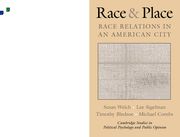Book contents
- Frontmatter
- Contents
- List of Figures
- List of Tables
- Preface
- 1 Introduction
- 2 Race Relations in Detroit, 1968–1992
- 3 Black–White Social Interaction
- 4 Perceptions of Racial Discrimination
- 5 Black Racial Solidarity
- 6 White Racial Prejudice
- 7 Opinions on Urban Issues: The Schools and the Police
- 8 Conclusions
- Appendix A The Detroit Surveys
- Appendix B Detroit Survey Items and Measures
- References
- Author Index
- Subject Index
- Miscellaneous Endmatter
1 - Introduction
Race and Residence
Published online by Cambridge University Press: 05 June 2012
- Frontmatter
- Contents
- List of Figures
- List of Tables
- Preface
- 1 Introduction
- 2 Race Relations in Detroit, 1968–1992
- 3 Black–White Social Interaction
- 4 Perceptions of Racial Discrimination
- 5 Black Racial Solidarity
- 6 White Racial Prejudice
- 7 Opinions on Urban Issues: The Schools and the Police
- 8 Conclusions
- Appendix A The Detroit Surveys
- Appendix B Detroit Survey Items and Measures
- References
- Author Index
- Subject Index
- Miscellaneous Endmatter
Summary
Residential segregation in the United States has proved resilient to change. Residential segregation has been and continues to be the “structural linchpin” of American race relations (Bobo, 1989: 307). This is in striking contrast to the progress that has been made in narrowing the racial divide in public accommodations, the workplace, universities, and the armed forces. The movement toward racially integrated housing has resisted the broader societal sweep of integration, and the residential separation of blacks and whites remains a huge impediment to progress toward racial equality (Farley, Bianchi, and Colasanto, 1978a: 98).
After increasing steadily for most of the 20th century, however, housing segregation finally began to diminish during the 1980s and 1990s (Massey and Denton, 1987; Farley and Frey, 1994; Massey, 2000, see also Taeuber and Taeuber, 1965). During those years, most American metropolitan areas became less racially segregated within the borders of the central city, and many experienced an exodus of African Americans to the suburbs. Indeed, this movement of blacks to the suburbs was a major reason for the small decrease in residential segregation (Schneider and Phelan, 1993).
Although demographers have tracked these migratory patterns (Farley and Frey, 1994; Massey and Denton, 1993, O'Hare and Usdansky, 1992), little is known about the impact of such movement on the way blacks and whites think about themselves and one another. Does it matter whether blacks and whites live in mixed neighborhoods or in relatively integrated cities?
- Type
- Chapter
- Information
- Race and PlaceRace Relations in an American City, pp. 1 - 18Publisher: Cambridge University PressPrint publication year: 2001
- 1
- Cited by



